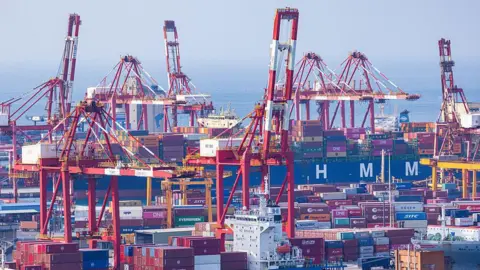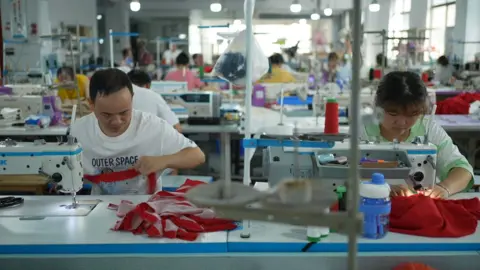Asia Business Correspondent
 Getty Images
Getty ImagesWhen he began his trade war, President Donald Trump said his goal was to bring American jobs and manufacturing back to the US, reduce trade deficits and create a more level playing field for American companies competing globally.
But after months of negotiations and many countries’ refusal to meet America’s demands, his strategy has taken a more punitive turn.
US companies have been here before.
Under Trump’s first administration, when he imposed tariffs on Chinese exports, they scrambled to limit their exposure to Beijing, with many shifting production to Vietnam, Thailand and India to avoid higher levies.
But his battery of new tariffs does not spare any of these economies. Stocks saw a sell-off, with benchmark indexes in Taiwan and South Korea in the red on Friday.
Both countries are central to Asia’s sprawling electronics production.
The details are still hazy, but US firms from Apple to Nvidia will likely be paying more for their supply chains – they source critical components from several Asian countries and assemble devices in the region.
Now they are on the hook – for iPhones, chips, batteries, and scores of other tiny components that power modern lives.
It’s not good news for Asian economies that have grown and become richer because of exports and foreign investment – from Japanese cars to South Korean electronics to Taiwanese chips.
Soaring demand for all these goods fuelled trade surpluses with Washington over the years – and has driven President Trump’s charge that Asian manufacturing has been taking American jobs away.
In May, Trump told Apple CEO Tim Cook: “We put up with all the plants you built in China for years… we are not interested in you building in India, India can take care of themselves.”
 Getty Images
Getty ImagesApple earns roughly half its revenue by selling iPhones that are manufactured in China, Vietnam and India.
The tech giant reported bumper earnings for the three months to June, hours before Trump’s tariff announcement on Thursday night, but now the future looks more uncertain.
Chief executive Tim Cook told analysts on a conference call that tariffs had already cost Apple $800m (£600m) in the previous quarter, and may add $1.1bn in costs to the next quarter.
Tech companies typically plan years ahead, but Trump’s unpredictable tariff policy has paralysed businesses.
Amazon’s online marketplace, for instance, is just as dependent on China for what it sells in the US.
But it’s not yet clear what rates Chinese imports into the US could face because Beijing has yet to strike a deal with Washington – it has until 12 August to do so.
Before they agreed to de-escalate, the two sides imposed tit-for-tat tariffs that reached a staggering 145% on some goods.
 Getty Images
Getty ImagesBut it’s no longer just about China.
On Thursday, Mr Cook said that most iPhones sold in the US now come from India. But Trump has just levelled a 25% tariff on Indian imports, after Delhi was unable to clinch a deal in time.
Other firms chose to re-route their goods bound for the US through Vietnam and Thailand after the tariffs in Trump’s first term. It became so common that it was called the “China+1” strategy. But this time, these trans-shipped goods are also being targeted.
In fact, trans-shipping has been a big part of the US negotiations with Asian countries. Vietnamese imports face a 20% US levy but trans-shipped goods face 40%, according to Trump.
It’s harder still for advanced manufacturing like semiconductors – more than half of the world’s chips, and most of its advanced ones, come from Taiwan. It is now subject to a 20% tariff.
Chips are the backbone of Taiwan’s economy, but also central to US efforts to gain a technological lead over China. So it is another US company, Nvidia, that will pay steep levies to put advanced chips by Taiwan’s TSMC inside its AI products.
 Xiqing Wang/BBC
Xiqing Wang/BBCBut perhaps the biggest casualty of Trump’s tariffs could well be Asia’s e-commerce giants – as well as the American companies that rely on Chinese sellers and marketplaces.
In a surprise move this week, Trump ditched the “de minimis” rule which exempted parcels under $800 from customs duties.
He first did this in May, targeting such parcels from China and Hong Kong – and this was a blow for retailers like Shein and Temu, whose huge success has come from online sales in the West.
Now American sites like eBay and Etsy have also lost that exemption – and the price of second-hand, vintage and handmade items for US customers will go up.
President Trump says he is batting for Americans with these tariffs, but in a deeply globalised world, US firms and customers could also become casualties.
There is still so much uncertainty that it is hard to see who the winners really are.


